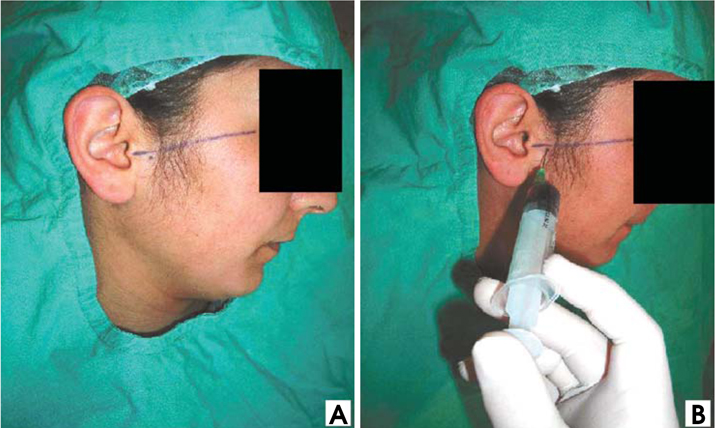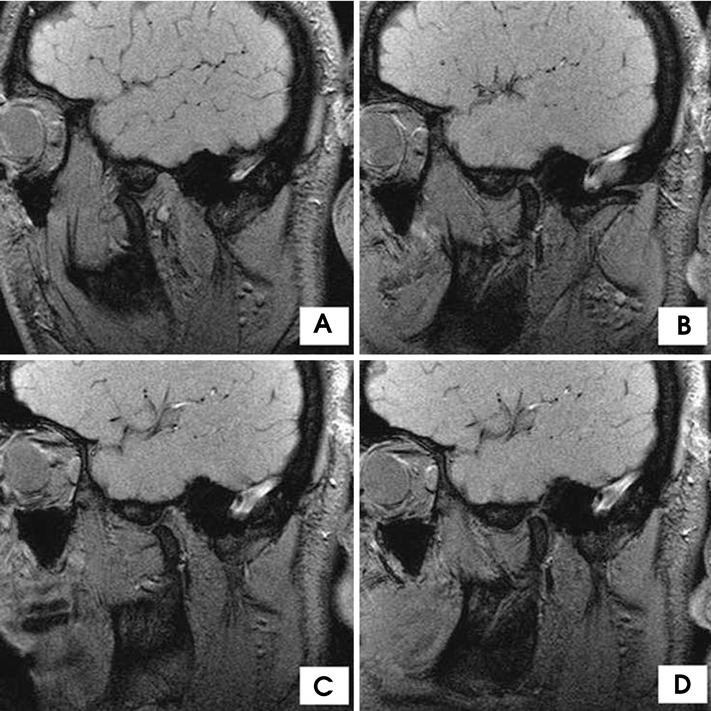Imaging Sci Dent.
2012 Mar;42(1):13-18. 10.5624/isd.2012.42.1.13.
Autologous blood injection to the temporomandibular joint: magnetic resonance imaging findings
- Affiliations
-
- 1Department of Oral and Maxillofacial Surgery, Faculty of Dentistry, Karadeniz Technical University, Trabzon, Turkey. drcandarli@hotmail.com
- 2Department of Plastic, Reconstructive Surgery, Fatih University Hospital, Ankara, Turkey.
- 3Department of Emergency Medicine, Fatih University Hospital, Ankara, Turkey.
- 4Department of Radiology, Fatih University Hospital, Ankara, Turkey.
- KMID: 1974402
- DOI: http://doi.org/10.5624/isd.2012.42.1.13
Abstract
- PURPOSE
The aim of this study was to investigate the effect of the autologous blood injection (ABI) for chronic recurrent temporomandibular joint (TMJ) dislocation using magnetic resonance imaging (MRI).
MATERIALS AND METHODS
ABI was applied to 14 patients who had chronic recurrent TMJ dislocation. MRIs of the patients were taken and compared before and one month after the injection.
RESULTS
All of the patients had no dislocations of their TMJs on clinical examination one month after the injection. In the pre-injection, unilateral or bilateral TMJ dislocations were observed on MRIs in all patients. One month after the injection, TMJ dislocations were not observed in MRI evaluation of any patients. A significant structural change that caused by ABI was not observed.
CONCLUSION
The procedure was easy to perform and it caused no foreign body reaction. However, it was unclear how the procedure prevented the dislocation.
MeSH Terms
Figure
Cited by 1 articles
-
Temporomandibular joint dislocation: experiences from Zaria, Nigeria
Rowland Agbara, Benjamin Fomete, Athanasius Chukwudi Obiadazie, Kelvin Idehen, Uche Okeke
J Korean Assoc Oral Maxillofac Surg. 2014;40(3):111-116. doi: 10.5125/jkaoms.2014.40.3.111.
Reference
-
1. Machon V, Abramowicz S, Paska J, Dolwick MF. Autologous blood injection for the treatment of chronic recurrent temporomandibular joint dislocation. J Oral Maxillofac Surg. 2009. 67:114–119.
Article2. Hasson O, Nahlieli O. Autologous blood injection for treatment of recurrent temporomandibular joint dislocation. Oral Surg Oral Med Oral Pathol Oral Radiol Endod. 2001. 92:390–393.
Article3. Oztan HY, Ulusal BG, Turegun M, Deveci M. Titanium screw implantation to the articular eminence for the treatment of chronic recurrent dislocation of the temporomandibular joint. Int J Oral Maxillofac Surg. 2005. 34:921–923.
Article4. Ziegler CM, Haag C, Mühling J. Treatment of recurrent temporomandibular joint dislocation with intramuscular botulinum toxin injection. Clin Oral Investig. 2003. 7:52–55.
Article5. Kato T, Shimoyama T, Nasu D, Kaneko T, Horie N, Kudo I. Autologous blood injection into the articular cavity for the treatment of recurrent temporomandibular joint dislocation: a case report. J Oral Sci. 2007. 49:237–239.
Article6. Fu KY, Chen HM, Sun ZP, Zhang ZK, Ma XC. Long-term efficacy of botulinum toxin type A for the treatment of habitual dislocation of the temporomandibular joint. Br J Oral Maxillofac Surg. 2010. 48:281–284.
Article7. Vázquez Bouso O, Forteza González G, Mommsen J, Grau VG, Rodríguez Fernández J, Mateos Micas M. Neurogenic temporomandibular joint dislocation treated with botulinum toxin: report of 4 cases. Oral Surg Oral Med Oral Pathol Oral Radiol Endod. 2010. 109:e33–e37.
Article8. Daif ET. Autologous blood injection as a new treatment modality for chronic recurrent temporomandibular joint dislocation. Oral Surg Oral Med Oral Pathol Oral Radiol Endod. 2010. 109:31–36.
Article9. Pinto AS, McVeigh KP, Bainton R. The use of autologous blood and adjunctive 'face lift' bandage in the management of recurrent TMJ dislocation. Br J Oral Maxillofac Surg. 2009. 47:323–324.
Article10. Lafeber FP, Miossec P, Valentino LA. Physiopathology of haemophilic arthropathy. Haemophilia. 2008. 14:Suppl 4. 3–9.
Article11. Roosendaal G, Lafeber FP. Blood-induced joint damage in hemophilia. Semin Thromb Hemost. 2003. 29:37–42.
Article12. Roosendaal G, TeKoppele JM, Vianen ME, van den Berg HM, Lafeber FP, Bijlsma JW. Blood-induced joint damage: a canine in vivo study. Arthritis Rheum. 1999. 42:1033–1039.
Article13. Hooiveld MJ, Roosendaal G, Jacobs KM, Vianen ME, van den Berg HM, Bijlsma JW, et al. Initiation of degenerative joint damage by experimental bleeding combined with loading of the joint: a possible mechanism of hemophilic arthropathy. Arthritis Rheum. 2004. 50:2024–2031.
Article14. Hooiveld M, Roosendaal G, Vianen M, van den Berg HM, Bijlsma J, Lafeber F. Blood-induced joint damage: longterm effects in vitro and in vivo. J Rheumatol. 2003. 30:339–344.15. Candrl C, Yüce S, Yldrm S, Sert H. Histopathologic evaluation of autologous blood injection to the temporomandibular joint. J Craniofac Surg. 2011. 22:2202–2204.
- Full Text Links
- Actions
-
Cited
- CITED
-
- Close
- Share
- Similar articles
-
- Computed tomography and magnetic resonance imaging characteristics of giant cell tumors in the temporomandibular joint complex
- Diagnostic Reliability & Case Reports Of The Dynamic MRI For Temporomandibular Joint Disease
- Comparison of MRI findings with clinical symptoms in temporomandibular joint internal derangement
- A comparison of clinical symptoms and magnetic resonance images in temporomandibular joint disorders
- Observation of bilaminar zone in magnetic resonance images of temporomandibular joint




